Bitcoin is a Decentralized Organism (Mycelium) — Part 1/4
Bitcoin is a Decentralized Organism (Mycelium) — Part 1/4
By Brandon Quittem
Posted December 11, 2018
- Part 1 - Bitcoin is a Decentralized Organism
- Part 2 - Bitcoin is a Social Creature
- Part 3 - Bitcoin is the Antivirus
- Part 4- To Be Posted
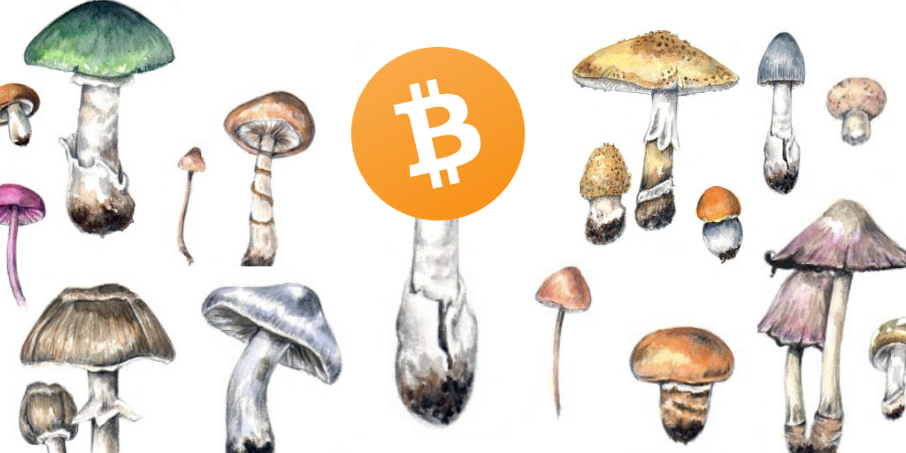 Original Artwork by Emmaline Bailey
Original Artwork by Emmaline Bailey
Forward
First, I need to give credit to Dan Held for publishing his 4-part series comparing bitcoin’s origin to planting a tree. While I loved his series, I believe a more robust analogy is comparing bitcoin to fungi. If you’re new to this topic, strap in — it is my honor to initiate you into the fascinating world of fungi.
Polymathic responsibility : Just as Satoshi combined separate disciplines to stitch together a franken-technology we call bitcoin… It is my belief that each of us has the responsibility to explore our unique cross sections of knowledge. Here’s my exploration of fungi and bitcoin — the parallels are astounding.
Introduction
Bitcoin appears superficially simple upon first glance, however truly understanding the system is a daunting task.
“Intellectual traps” exist along the way, tricking observers into making hasty assumptions. I liken the pursuit of understanding bitcoin to a mountain climber continually reaching “false peaks” that momentarily fool the climber into thinking they’ve reached the actual summit.
As soon as you think you have bitcoin figured out, you discover how little you actually know (false peak).
Competing narratives make it even more challenging… Magic internet money, speculative mania, fintech revolution, bitcoin boils the oceans, rat poison squared, libertarian idealism, digital gold, apex predator of monetary media, gordian knot of interlocking incentives, etc.
To make matters more complicated, bitcoin is a living system constantly changing based on environmental stimuli. True understanding is a moving target unlikely to ever be hit.
Attempting to answer the question “what is bitcoin,” I found exploring parallels to the natural world to be particularly illuminating.
In particular, some of bitcoin’s best characteristics are simply reflections of successful evolutionary strategies found in nature, specifically in the fungi kingdom.
Fungi are predominantly made up of “mycelium” — an underground decentralized intelligence network described by Paul Stamets as “earth’s natural internet.”
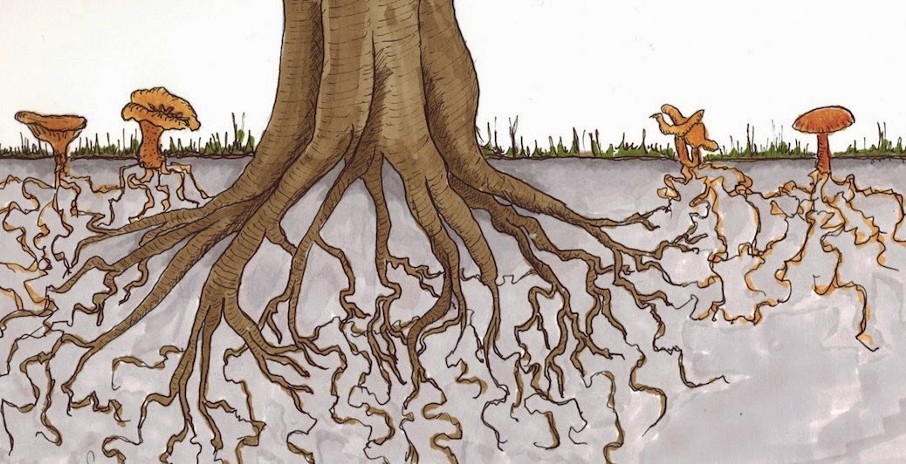 Image credit: John Upton
Image credit: John Upton
“I believe that mycelium is the neurological network of nature. Interlacing mosaics of mycelium infuse habitats with information-sharing membranes. These membranes are aware, react to change, and collectively have the long-term health of the host environment in mind. The mycelium stays in constant molecular communication with its environment, devising diverse enzymatic and chemical responses to complex challenges.”
― Paul Stamets,Mycelium Running: How Mushrooms Can Help Save the World
In this essay I’m going to explore the similarities between fungi and bitcoin in 3 parts, each representing a different stage in the life cycle of common fungi.
- Part 1: Bitcoin as a decentralized network architecture (Mycelium) — this one
- Part 2: Bitcoin as a social phenomenon (Mushrooms)
- Part 3: Bitcoin as a catalyst for human evolution (Reproduction/Sporulation) — coming soon!
Introduction to Fungi
My favorite TED Talk: 6 Ways Mushrooms Can Save the Word (Paul Stamets)
Fungi are in their own separate kingdom just like plants and animals. There are more fungi species than plants and animals combined.
Animals are more closely related to fungi than we are to plants. Both fungi and animals inhale oxygen and exhale carbon dioxide. Plants produce their own food through photosynthesis (autotrophic) while animals and fungi must find their own food (heterotrophic). Animals evolved to have internal stomachs/brains whereas fungi pursued external stomachs/brains.
Fungi Fact #1: humans share over 50% of their DNA with fungi. Scientists proposed a new super kingdom called Opisthokoncombining Fungi and Animals.
Fungi can take many forms. Most organize in an underground “root structure” called mycelium that’s found nearly everywhere on this planet.
When conditions are right, fungi produce mushrooms which then release spores (seeds) that attempt to colonize life in a nearby location. Mushrooms are simply the reproductive organ. Mushrooms are to the mycelium what apples are to a tree.
Fungi are paramount to life on earth:
- The largest organism on our planet is a fungal network
- Fungi are the best chemists on our planet, much of our medicine comes from fungi
- Trees cannot survive without underground fungal allies
- Fungi have been around for 1.3b years surviving all 5 great extinction events
- Fungi are capable of saving the bees
Fungi are Decentralized Intelligence Networks
Fungal networks don’t have a centralized “brain.” Instead, they are a one-cell walled “root system” called Mycelium. This underground stomach and distributed intelligence network is capable of sending information bi-directionally over long distances and even across species lines. These fungal networks constantly evolve based on feedback from their environment.
At any one point, a fungal network contains millions of end points each searching for food, defending their territory, or inventing new molecules to subvert their competition (other fungi, bacteria, etc). These networks form a decentralized consensus on how to use resources, when to reproduce, and what strategy best defends the organism.
This mirrors the decentralized consensus (social contract) formed in bitcoin. Nodes determine what software they wish to run and enforce the consensus rules they support accordingly. Miners determine which transactions to include in blocks. Exchanges, wallets, and merchants each steward large groups of users. Each participant in bitcoin voluntarily chooses how they wish to participate and the aggregate consensus represents the network.
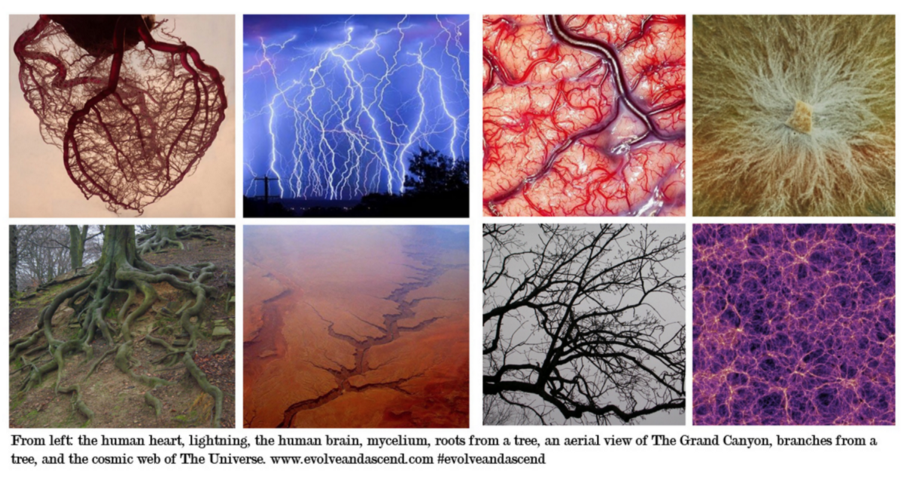
Decentralized Networks are Older Than Humanity
Decentralized networks have existed long before humans were around. In fact, fungi have been successfully implementing such systems for 1.3 billion years making them the most successful kingdom on our planet.
Besides fungi, there are several examples of distributed network archetypes found throughout nature (mycelium, dark matter, neurons, the internet, etc). Clearly this strategy works otherwise nature wouldn’t insist on replicating it.
When seen in the context of this long history of the decentralized network archetype, the advent of decentralized digital money seems less novel and more inevitable.
The decentralized network archetype is Lindy.
During a Billion Years of Evolution, Fungi Have Become Masters of Survival.
Fungi are uniquely adaptive and continue surviving mass extinction events.
65 million years ago a giant asteroid hit our planet killing most life (including the dinosaurs) on our planet. The impact created a cloud of smoke so thick that it blocked sunlight from reaching the earth’s surface for many years. Without sunlight, plants died off and with them most animals. Fungi however do not rely on sunlight to survive, they can adapt quickly, and can find their own food.
After each extinction event, fungi “inherit the earth” and slowly rebuild until conditions stabilize and life can continue again.
Bitcoin will become the most successful monetary specie because its decentralized, adapts (relatively) quickly, finds it’s own food (unmet demand), and doesn’t need government support. In the event of a mass monetary extinction event, bitcoin will “inherit the earth.”
Japanese Government vs the Humble Slime Mold
Whether it’s central banks trying to steer the economy or hierarchical corporations trying to maximize value in the information age… Central planning has many flaws.
When making decisions in the “information economy,” decentralized or flat organizations are more effective. They resist corruption, minimize bureaucracy, and push decision making to the extremities where individuals (nodes) have the most up to date information about the problem at hand.
Let’s take a look at the Tokyo subway system to illustrate the power of decentralized networks.
Scientists conducted an experiment where an ancient fungus (slime mold) was incentivized to recreate the Tokyo subway system. Each subway stop (node) was marked with the slime molds favorite food (oat flakes).
After a short while, the slime mold grew to connect all the nodes/stops in a more efficient design than the centrally planned committee of engineers hired by the Japanese government.
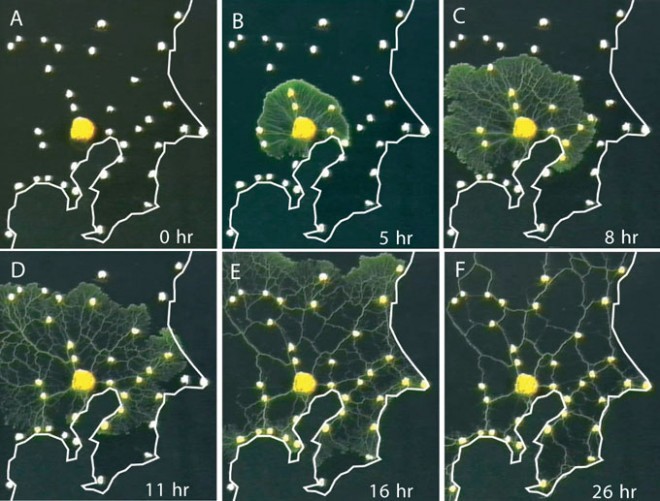 Slime Mold designing Tokyo Subway System
Slime Mold designing Tokyo Subway System
From the Abstract:
Transport networks are ubiquitous in both social and biological systems. Robust network performance involves a complex trade-off involving cost, transport efficiency, and fault tolerance. Biological networks have been honed by many cycles of evolutionary selection pressure and are likely to yield reasonable solutions to such combinatorial optimization problems. Furthermore, they develop without centralized control and may represent a readily scalable solution for growing networks in general. We show that the slime mold Physarum polycephalum forms networks with comparable efficiency, fault tolerance, and cost to those of real-world infrastructure networks — in this case, the Tokyo rail system. The core mechanisms needed for adaptive network formation can be captured in a biologically inspired mathematical model that may be useful to guide network construction in other domains.
When you think of the costs and complexities involved in such an infrastructure project, it’s quite sobering to realize a slime mold can design a better network in a single day.
Satoshi understood the power of the slime mold.
Bitcoin is a non-sovereign monetary good that pushes complexity and decision making to the edge just like fungi. Over time, this free market decentralization allows bitcoin to out-compete various legacy financial systems who have little skin in the game, suffer from the innovator’s dilemma, become more fragile over time, and often drown in bureaucracy (or worse).
Life Without a Centralized Point of Failure
Mycelium has no “central point of control.” Any individual part can be removed but the system as a whole survives.
Bitcoin functions the same way: as any one developer, node, miner, exchange, or user may be vulnerable yet not crucial for its survival. No one to jail, no one to shut down, no essential hardware to seize. Anytime one attacks bitcoin/mycelium but doesn’t successfully kill it, the system gets stronger.
“If you come at the king, you best not miss” — Omar Little (The Wire)
Nation states and central banks face a paradoxical challenge. If they attempt to destroy their competition, they’ll highlight the very need for bitcoin in the first place. And yet, the longer they wait, the stronger bitcoin becomes.
Hardened from hostility
Both mycelium and bitcoin endure in the most competitive ecosystems on our planet and must constantly adapt in order to survive. They have skin in the game and become hardened from hostility.
Fungi are in a 24/7 competitive environment, constantly fighting little underground battles against various bacteria, microbes, and competing fungi.
If one mycelial “node” senses a predator/prey, it sends information to the “mushroom scientists” who then create a new enzyme to target the predator/prey. The fungal network distributes this new enzyme where needed.
Over time, the fungi develops a chemical library that acts both as a robust immune system and improves its ability as a predator — enabling greater ecological success. It’s no wonder fungi can survive anywhere and continue to maintain dominance on our planet. Fungi are antifragile.
Fungi fact #2: As humans, we benefit from medicinal compounds created by fungi. Most famously: Penicillin, which came from an accidental discovery by Alexander Fleming. Penicillin has been used to combat bacterial epidemics that historically have decimated human populations. Since the discovery of Penicillin our population has tripled.
Bitcoin responds to its environment in a similar manner. As bugs/threats/opportunities are found in the system, information travels to the “bitcoin scientists” (developers) who create an “enzyme” (software patch) and this update propagates through the system. This enables greater ecology success for bitcoin too. Bitcoin is antifragile.
Both fungi and bitcoin harden their defenses over time and learn to consume new food sources. This has a compounding effect increasing antifragility as well as life expectancy over time.
In one extreme case, let’s take a look at the largest organism on our planet, the Honey Mushroom (Armillaria sp). Found in the Blue Mountains in Eastern Oregon, this single organism is over 2.4 miles (3.8 km) across. It’s estimated to be between 1,900 and 8,650 years old and is currently consuming an entire forest.
Dealing with Competition
Fungal networks steal competitive advantages from their neighbors in the form of genetic information just like bitcoin absorbs competitive advantages displayed by altcoins.
There is a (misguided) belief in which people assume that altcoins will implement cool new features that will eventually outcompete bitcoin.
The opposing camp believes that bitcoin will eventually absorb all the best features after they’ve been tested in the market which makes alternative currencies unable to compete over the long term. I stand in this camp.
Let’s take a look at how fungi approach their competition…
First we need to understand some basic genetics. Genes are typically passed down from parent to offspring in what’s known as “Vertical Gene Transfer.”
Interestingly, fungi perform “Horizontal Gene transfer” — effectively slurping up genetic information from different species competing in the same ecosystem.
Fungi “take what works” from other species that compete in the same ecosystem. This phenomenon can be observed by examining “dung loving” who are more closely related to each other than their genetic ancestors.
This process of horizontal gene transfer demonstrated by fungi foreshadows the future state where bitcoin integrates any proven ideas produced by alt coins at large.
For example: Combining the Lightning Joule Browser extensionwith a node (launch your own, use Casa, or otherwise) enables micro-transactions through your browser. This effectively eliminates the need for tokens like BAT.
You could even make the argument that bitcoin has been performing horizontal gene transfer since Satoshi first combined technologies used in previous attempts at electronic cash systems such as Hash Cash, E-gold, etc.
Arbitrage, Incentives, and Finding Their Place in Ecology
Fungi perform two ecological roles on this planet: they recycle all matter into base elements & act as our planet’s immune system.
“Mycelia are the grand disassemblers of nature” — Paul Stamets
Fungi spend their days quietly decomposing organic matter. They transform rocks, branches, leaf litter, dead animals, and oil spills into their base elements (carbon, nitrogen, oxygen, etc). Then fungi trade these valuable elements with nearby organisms.
Fungi fact #3: Our forests would be buried in hundreds of feet of leaves and branches if fungi didn’t decompose them and redistribute the nutrients.
In other words, fungi unlock stranded resources. A tree cannot re-use its own leaves or branches as the carbon/nitrogen/phosphorus are locked in an unusable form. Fungi exploit arbitrage opportunities in their ecosystem.
Bitcoin, Through its PoW Mechanism, Unlocks Stranded Resources in the Form of Energy.
Before we tackle bitcoin, let’s explore a fascinating historical example: How aluminum was used to “export stranded renewable energy” from a country like Iceland.
Iceland produces renewable geothermal energy, often in remote places. This leads to an excess supply that cannot reach the demand (energy doesn’t travel well over long distances).
Iceland took advantage of their excess energy by producing aluminum, which is a very energy intensive process. Iceland effectively turns excess energy into a durable store of value (Aluminum) which can be exported.
Bitcoin does the same thing. Instead of stranded energy “dying on the vine,” producers can mine bitcoin (or just sell excess energy to miners). This, too, enables excess energy production to be turned into a durable store of value. The second order effect is that bitcoin is effectively subsidizing renewable energy projects.
To explore this concept in depth, check out Dan Held’s Article: PoW is Efficient.
Fungi Fact #4: Fungi eating rocks is the main reason we have topsoil. Topsoil enables us to grow food. It took fungi over 1b years to produce just the 18 inches of topsoil that we have today.
Fungi (and Bitcoin) Are Ecological Immune Systems
Fungi are the immune systems for both the ecosystems in which they live and the planet at large.
Fungi produce medicinal compounds and protect their ecosystems through complex symbiotic relationships. Fungi broker resources underground (via mycelium) between species to ensure the health of the entire ecosystem.
[How trees secretly talk to each other in the forest What do trees talk about? In the Douglas fir forests of Canada, see how trees “talk” to each other…(https://video.nationalgeographic.com/video/decoder/00000165-61d1-d3b2-a17d-e9f9571f0000)
In crude terms, the fungi mine minerals underground for trees in exchange for sugars (food) that the tree produces through photosynthesis. Trees get increased protection from invaders and crucial minerals which they cannot find on their own. Ever wonder why the baby oak tree can survive on a forest floor where it receives no sunlight?
Each organism participating in this shared incentive system improves the evolutionary fitness of the forest. I believe forests are living super-organisms consisting of a variety of different species.
Bitcoin performs a similar ecological role
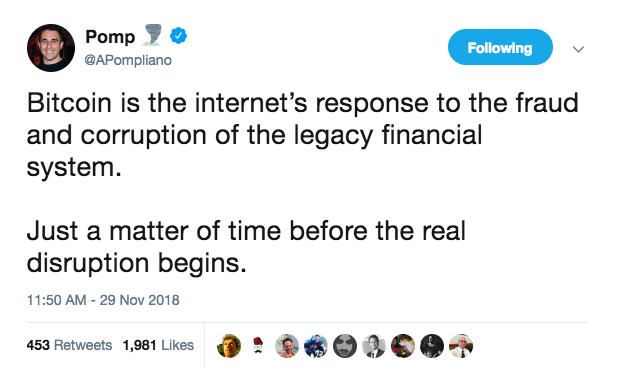 Recent tweet from Pomp
Recent tweet from Pomp
The market sends signals for bitcoin to create features that satisfy unmet demands or improve security as new threats emerge.
- Block space demand increases above capacity, Lightning Network is born.
- China cracks down on exchanges,LocalBitcoins.com flourishes.
- As Venezuela, Turkey, and Argentina hyper-inflate their currency, bitcoin steps in as a non-sovereign SoV.
- Blockstream launches Satellites able to broadcast bitcoin transactions to mitigate catastrophic events.
You could even make the case that bitcoin acts as humanity’s immune system — helping fight off cancerous governments, rent seeking businesses, central bank seigniorage, debasement of the monetary supply, and even one of humanity’s tragic faults: greed.
Positive feedback loop
Bitcoin also benefits from the aligned incentives between users, full nodes, miners, exchanges, and merchants. As bitcoin better adapts to its environment, it better meets the demands of its growing constituents, which in turn recruits more network participants. This positive feedback loop promotes sustained growth of the network.
Like the honey mushroom consuming entire forests in Oregon, bitcoin is getting bigger and stronger over time.
Conclusion
Did you enjoy this? Check out Part 2 where I examine bitcoin as a social phenomenon.
Bitcoin is hard to pin down. Is it technology? A get rich quick scheme? New age religion? Payment rails? Or is it primarily a social system (super-organism) made of individually replaceable cells that share aligned incentives? Join me as we explore these questions through the lens of Fungi in Part 2.
Follow me here on medium and twitter to be notified when future articles are released.
Fungi fact #5: I wrote most of this essay while consuming medicinal mushrooms used for cognitive enhancement (Lions Mane, Chaga, and Cordyceps).
Thanks for reading, Brandon
Acknowledgments
- Thanks to Dan Held,Nic Carter,Murad Mahmudov,Vijay Boypati,Pierre Rochard,Hasu, and many more for challenging my understanding of bitcoin.
- Thanks to Paul Stamets for pushing the boundaries of Mycology and inspiring me along the way.
- Thanks to my friends who convinced me I wasn’t crazy to compare mycelium and bitcoin in the first place. And for the edits: Rob Fox,Dan Liebeskind, Justin Evidon, Anne Rapp, and many more.
- Special thanks again to Dan Held whose Planting Bitcoin series motivated me to finally get these ideas written down and for providing notes on earlier versions of this essay.
